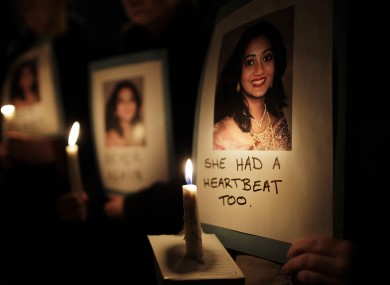David Walsh | Staff Writer
It has been almost a year since the death of Savita Halappanavar made worldwide headlines after her husband Praveen broke the news story to The Irish Times last November. Ms Halappanavar had died of sepsis following a miscarriage in Galway University Hospital on October 28th circumstances surrounding her death sparked a national outcry, accompanied by widespread calls from the media and wider public for a clarification of Irish abortion law.
Within Trinity, this publication’s coverage of the subsequent Never Again Protest for Savita caused the website to crash due to the traffic influx after Reddit made it their cover page. A preferendum result mandating the Students’ Union to adopt a pro-choice policy was to follow. In light of the publication of the third and final report into Ms Halappanavar’s death last week and the upcoming anniversary, the ramifications of this case in the national consciousness and its implications for Irish maternity services bear scrutiny.
At a quick glance, the repercussions of this case would seem obvious. It prompted a review of Ireland’s existing legislation on the conditions of a termination of pregnancy, culminating in the passing of the Protection of Life During Pregnancy Bill last July. The bill provided for legislation on the historic 1992 X-Case judgement by the Supreme Court, which stated that an abortion could be performed if there was ‘a real and substantial risk to the life of the mother’.
This was no easy task. Previous administrations had repeatedly shirked their responsibilities as legislatures, prevaricating over the issue for more than twenty years. Despite numerous calls from the European Court of Human Rights to legislate on the issue, its incendiary nature assured that it was all but swept under the rug for many years. It is to the coalition’s credit that the Supreme Court ruling was finally enacted in Irish law. What is striking about this legislation is the short space of time (a mere eight months) in which it was implemented following Savita’s death. The affirmative action that the political process took, spurred on by the public response, is perhaps an example that change at a more fundamental level has taken root in Irish life, aided undoubtedly by this case.
Despite numerous calls from the European Court of Human Rights to legislate on the issue, its incendiary nature assured that it was all but swept under the rug for many years
It is said of Ireland that change is often unwelcome and frequently slow. How very un-Irish it would seem that steps were taken to address these legislative inadequacies within the political system promptly and without delay. There are many reasons to account for this uncharacteristically swift change. Ms Halappanavar’s death shocked people at all levels of national life. When it emerged that Savita had asked for a termination of pregnancy not once but on a number of separate occasions, only to be refused owing to Irish law and again rather appallingly on the grounds that Ireland was ‘a Catholic country’, shock quickly turned to outrage. It was our ineffective and ambiguous laws, whether directly or indirectly, that played a hand in her death. An overriding sense of the utter failure of the health service in protecting a vulnerable woman permeated Irish society. Ireland had a place on the world stage once again for the wrong reasons. A tipping point had been reached.
It was our ineffective and ambiguous laws … that played a hand in her death
Support for concrete action galvanised across a broad spectrum of Irish society, and public demand for an acceleration of new legislation, buoyed by an invigorated pro-choice movement, propelled a deflated government to act. And rather surprisingly, act they did, and whilst the legislation has been accused by some to not go far enough in preventing cases like Savita’s, the previous uncertainty that medical staff had faced in such circumstances has been lifted. It is testament to the ability of the public to effect change in national life if there is an impassioned but clear voice calling for it.
Even national tendencies towards procrastination may be set aside it seems when the calls are loud enough. It will be interesting to see if this same appetite for reform is adopted to address the more glaring shortcomings in our national maternity services that have arisen from the case.
For the three reports published into the death of Ms Halapanavar are unequivocal in their judgements that a lack of basic medical care lay at the heart of the case’s fatal outcome. HIQA (Health Information and Quality Authority) , the most recent of reports, in particular identified thirteen ‘missed opportunities’ in Savita’s medical treatment which if detected and acted upon ‘may’ potentially have resulted in a different outcome for her’. Staff did not recognise and act upon signs of her clinical deterioration in an efficient or timely manner, according to the report, ‘failing in the most basic elements of human care’. Worryingly on a national scale, it warns that maternity services may on occasion not be as safe as they should be, or of sufficient quality, calling for a full review into these services by the HSE and the Department of Health. This report’s findings confirm similarly to the HSE’s conclusions that medical error is as much to blame as any legislative fault in this case.
Thus, notwithstanding the introduction of the abortion bill, many of the determining factors in the case, such as the current management and knowledge of sepsis, may as have yet be unresolved. The recent announcement of a review launched by the West/North-West Hospitals Group into the actions of all staff members involved in Savita’s care is a welcome step. It is vital to the continued confidence in our health services that those who deliver them are seen to act accordingly and in best practice at all times. It is also up to the public to ensure that reform of this kind is implemented and to impress upon the relevant authorities that the mistakes of this case are unacceptable. The practice of ignoring the overwhelming call to act is surely a national trait best left in the past.
A year on from the release of this story into the public conscience, the facts of the case have certainly become a little clearer but discrepancies remain over medical staff’s responsibility or the degree to which intervention by termination may have effected the final outcome. Pending the civil suit recently announced by Savita’s husband Praveen, it would appear that these questions will remain circling in the public domain for some time longer. Unfortunately, it often takes a painful story as this to jolt a lethargic political system to action. They serve as potent warning signals of the continued dysfunction in our society; a call to act that necessitates a purposeful response but which frequently falls on deaf ears.
Here in Ireland, it is to our shame that too often we have opted for the latter. However as recent events have demonstrated, either in the passing of the abortion bill or even in the muted plans to reform the Seanad after the Government’s rejected referendum, an appetite for change and to see change come about has become a national priority. At present, it is still too early to tell but perhaps the tragedy of Savita Halappanavar may yet prove to have been the catalyst for this significant shift in Irish life.







